Sunday 30 December 2012
Brian Tracy: Achieving Goals is Predictable
Great interview with Brian Tracy on Achieving Goals.
Labels:
Brian Tracy,
secrets of success,
success,
success tips
Wednesday 19 December 2012
The 7 Biggest Mistakes in Social Media Marketing (and How to Avoid Them)
Social media has been around for a while now, and we know that 88 percent of all businesses are now on social media sites in some capacity. That being said, if we look at businesses actually getting value from social media, the number would be much smaller.
I've had the pleasure of working with thousands of businesses on their social media marketing strategies for over six years, and interestingly, the mistakes and barriers to success are the same today as they were when I got started.
Here are the biggest mistakes (and how to avoid them of course).
1-Not having a plan.
Many businesses today still don't have an actual plan or strategic objectives for their social media marketing. They simply "get on Facebook" and assume that posting stuff and having people like them will lead to business value. This isn't necessarily true. To be successful at achieving business goals you need a clear plan for what you want to achieve.
2-Not optimizing content.
One of the most popular questions I get asked is how to connect Twitter, Facebook, LinkedIn, and Google+ accounts so that the same post will spread simultaneously to all accounts. There are tools that let you do this, but why bother? You'll end up with content that isn't right for the medium, and people will start to ignore you. Take a few extra minutes to customize your post for each medium.
3-Posting whatever comes to mind.
Most people decide what to write and then bang away at the keyboard to create a Twitter or Facebook post. Stop, take five minutes, and think about how you can improve it. Can it be more interesting? Can you make it funny? Can you add a relevant stat? Stop vomiting boring crap on your social networks and spend some actual time thinking about what you are going to post!
4-Telling instead of showing.
Stop telling people what you want them to believe about your business and start showing them. I don't have to tell people that I am knowledgeable about social media because I show people with reports, videos, and blog posts. Think about your key value proposition and point of difference vs. your competition, and figure out how to show people via social media.
5-Forgetting relationships.
Relationships still count, and since the dawn of social media people have been preaching the value of conversations and engagement. Remember, you are talking to actual people. They want to be treated with care and respect. Don't just post stuff, but participate and build relationships.
6-Being boring.
Many of the social media accounts that I look at are just plain boring. I'm not sure that there is a formula for interestingness, but (this links back to No. 3) think about how to make your message interesting to your audience: compare it to something else; use a picture or video; find a more relevant way to share your angle. Just stop being boring.
7-Losing focus.
If you try to talk to everyone you'll end up talking to no one. Be focused in your content and your audience. We know that niche content does better online. Be focused and disciplined and you'll be rewarded with loyal followers. Try to please everyone and most people will ignore you.
What mistakes are you seeing in social media? What challenges do you face?
source: http://www.clickz.com/clickz/column/2224663/the-7-biggest-mistakes-in-social-media-marketing-and-how-to-avoid-them
author:Krista Neher
images:http://socialmediainbusiness.com/tag/social-media-applications
Thursday 13 December 2012
Facebook Advertising Guide: All Ad Types and Specs
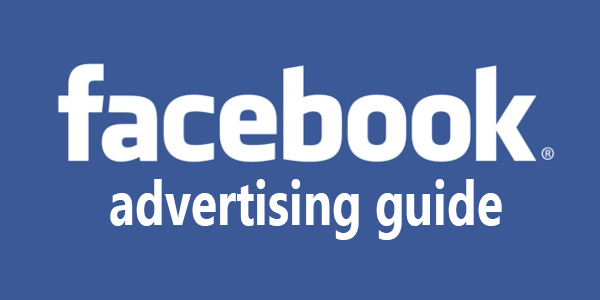
You may love or hate Facebook, but surely it has gained its place in the marketing mix of small business owners. However, despite Facebook’s continuous efforts to drive more businesses to the platform, the information available to potential advertisers is somewhat confusing. This is why this post is a starter’s guide to Facebook advertising, explaining the difference among all the different ad formats.
Facebook Advertising
1. Domain Ads

These ads are the standard solution for advertisers. They run on the right-hand side of the screen on any Facebook page. This type of had can feature up to 25 characters for the headline and 90 for the content. Images are limited to just 99 x 72 pixels, therefore pay attention to readability, if you intend to place some call to action in the image.
2. Page Like Ads

Page Like Ads are not very different from domain ads. However, their purpose is to direct Facebook users to Facebook Pages, Apps, or Events instead of external domains. The specs (characters, picture size) don’t differ from domain ads, except for the headline, that that cannot be edited as it correspond to the name of the Facebook Page, App or Event you are advertising. This is limited to 35 characters.
3. Page Post Ads
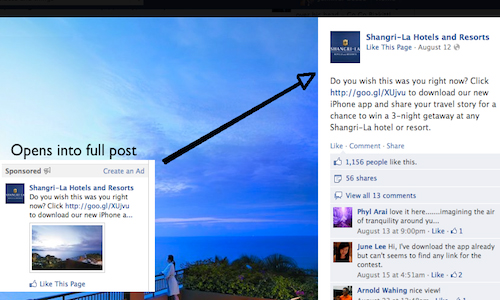
Page Post Ads are probably the best way to engage users and direct them to Facebook Pages. This format allows advertisers to use any “object” they have already posted on their Facebook page and turn it into an ad. In fact a page post ad can be any of the following:
- Page post text ad
- Page post photo ad
- Page post video ad
- Page post link ad
- Page post question ad
- Page post offer ad
- Page post event ad
Page Post Ads are limited to 120 character limit. In case your post text was longer than 120 characters, Facebook will only show the first 120 characters and add three small dots.
Page post ads can also be created directly through the “Promoted” button when posting something.
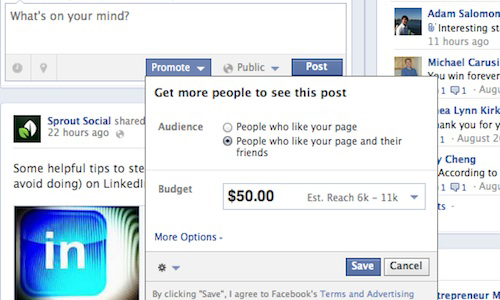
The way the ad is displayed also depends from the target audience, as non-fans will see a “Like” button and will be able to like the page directly from the ad. Current fans instead will see a sponsored story. What is a sponsored story? Read below.
4. Sponsored Stories
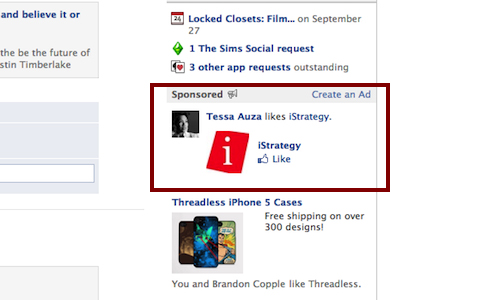
Sponsored stories are probably the trickiest format to understand. So-called (by Facebook) also “voice of friend”, they show users their friend’s interaction with the advertising brand. They always include the friend’s profile picture and their name, along with the action they performed.
This is an extract of how they work (from Facebook Education Resources):
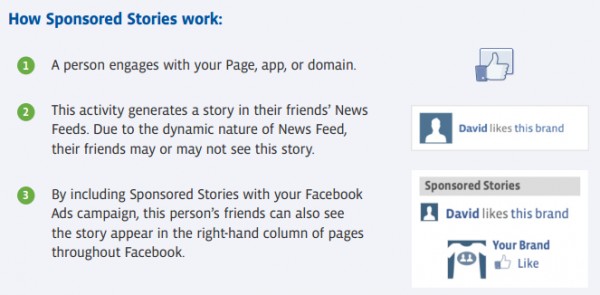
Sponsored stories are displayed only to the friends who took one of these actions:
Liked a Page or a Page post in the last 7 days
Checked into a place or claimed a deal in the last 7 days
Used an app/played a game twice or for >10 min in the last 30 days
Shared an app in the last 14 days
Liked, shared, or posted content from your domain in the last 7 days
You can target mobile-only, desktop-only, or just news feeds.
6. Facebook Offers
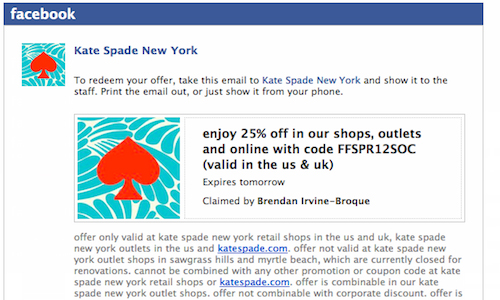
Facebook Offers are a relatively new format that allows local businesses (and more) to advertise coupon codes directly to potential customers. In order to access the discount code, fans have to “claim” the offer by clicking the relevant button. Despite being free to create, their reach is limited, unless advertisers pay for it (surprising, huh?), by turning it into a page post offer ad, like any other page post. Unless promoted, offers only appear in a small share of fans’ news feeds. And their friends will only see it if the offer is claimed.
All the above ad formats can be split between two main categories: Facebook ads and sponsored stories. The bid mechanism is similar to Google Adwords, as the CPC or CPM (cost per thousand impressions) advertisers are charged is determined by a Vickrey auction.
See also : 5 New Ways to Improve Your Facebook EdgeRank
Hope this starter’s guide will be of use to you. If you have any questions, hit me up with questions by commenting below. Good luck!
http://onlineincometeacher.com/socialmedia/facebook-advertising-guide/
Author: Daniel Nathan
Monday 10 December 2012
Maximizing Your Small Business Potential Through Email Marketing
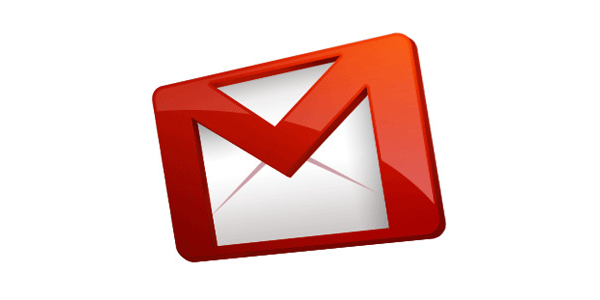
A lot of businesses have been using email marketing for a while, and it has become so common that you might not even think about it as “marketing.” Nevertheless, every time you open an email newsletter, promotional offer or even a “thank you” for buying a product, you are on the receiving end of an email marketing campaign. So let’s get right down to the basics of what email marketing is and whether or not it’s right for you and your small business.
What is Email Marketing?
Email marketing, in the most general sense, is exactly what it sounds like. It refers to marketing campaigns driven by email. But what does that mean? Think about this: every time you’ve ever received a promotional pamphlet on the street, or been handed a coupon for spending X amount of dollars at a retailer, or even simply read a magazine, you’ve been participating in “paper marketing.” Now imagine that instead of being handed a pamphlet, a coupon or a magazine, you receive in your email inbox a promotional message, a printable 10% off coupon, and a company newsletter from a small business. That would be an example of how email marketing works.
Why Email Marketing?
People use email marketing because it works, and it works extremely well, if done correctly. Email marketing allows for a secondary outlet of direct sales, data-driven results, and fosters the relationship between you and your customer. You may have to spend a little bit on email marketing software applications or services, but the amount of money that you save by not using paper and stamps, as well as the proven efficacy of the approach, makes it more of an appealing venture for most businesses. In fact, many small businesses use email marketing in conjunction with social media campaigns as well as; Quick Response (QR) code campaigns and experience great success with this multilateral approach. To top it all off, all of these campaign ideas are environmentally friendly.
Are There Any Downsides to Email Marketing?
There are a couple of downsides if you do not engage in email marketing correctly. A lot of users might label marketed emails as spam, which is something that you do not want. In fact, there are certain situations in which you might be unconsciously breaking the law by not adhering to specific anti-spam guidelines while email marketing!
For example, you cannot send emails to people that have not already agreed to receive them by other means. Fortunately, there are ways to drive reputable email marketing campaigns that adhere to all of the guidelines and do not get you or your small business blacklisted as spam. Unfortunately, without that know-how, you are looking at either studying up or hiring a third party. And to top it all off, you have to make sure that the emails that you are sending are relevant, effective, and aesthetically pleasing. This means design, layout, editing, etc. Without these skills you may be hiring out-of-the-office help, and that can get to be a bit expensive.
Is It For You?
I would definitely suggest looking into it. The numbers don’t lie (you can see them here), and plenty of small businesses profit from the switch rather than suffer from it, as long as they do it correctly. As mentioned before, email marketing utilized in conjunction with social media sites can be a great way to enhance and stimulate your base of loyal followers by sending out printable coupons and exclusive promotional information. However, you may find that the cost outweighs the benefit for you and your company when it comes to email marketing.
There are free trial versions of email marketing software out there as well as more professional programs to use. My suggestion is to try out one or two of these, explore it a little bit, and use that to make your decision. There are pros and cons to this marketing approach, so make sure that you take both into consideration and weigh them out when deciding the future of your small business.
Do you use email marketing for your business? If so, which email marketing provider do you use? If you don’t use any email marketing, do you have any questions you would like answering? Let us know by leaving your comments below!
http://onlineincometeacher.com/business-tips/maximizing-potential-through-email-marketing/
author:Miles Hall
Thursday 6 December 2012
Zig Ziglar - Attitude Makes All The Difference
Here is a Tribute to the late Zig Ziglar (November 6, 1926 – November 28, 2012).
RIP
Labels:
success,
success tips,
zig ziglar
Saturday 1 December 2012
5 Ways To Do Social Media Marketing The Right Way
Unlike what is generally perceived by people, marketing is not limited to just sales and promotions. Marketing is a holistic process that starts long before a business opportunity, when a market or a product is identified or created. One of the mediums used for marketing is social media. Social media marketing encompasses almost all areas that traditional marketing includes, such as customer research, promotion, sales, and customer feedback. It is also possible for businesses to execute their marketing activities strictly through social media. Social media includes social networking sites, cell phones and any other medium that people use to interact with each other.
Social Media Marketing Tools

Image by ‘ralphpaglia’
We have heard quite a lot about the different social networking sites used by businesses to carry out their social media marketing techniques. However, not enough light has been shed upon the various tools used to maximize the benefit derived out of social media. Social media tools are used by experts to analyse holistic trends, related to different issues being talked about on social networking sites. They also include practices that boost the effectiveness of the social media features. Some of them include:
1. Social Media Measurement
Just the way businesses carry out surveys to find the extent to which customers are aware about their brands, social media measurement tools quantify the presence of certain marketing content on social media such as social networking sites, micro-blogs, news sites, blogs, and other forums. An area that compliments social media measurement is social media monitoring. A collection of professionals, that includes sales teams, social engagement staff, marketing teams and PR staff, is used to gain insights into not only the presence of a certain brand, but other areas as well such as:
User interaction involving the discussion of the brand in question
Users expressing an increase in desirability of the brand
Impact of social media marketing on online sales
Change in competitors’ social media marketing strategy as a response to the brand’s strategy
Target market’s consumer behaviour in general and their inclination towards other issues, products, and brands
Since the area of social media measurement and monitoring has recently emerged, tools related to it are still developing. The ones that are present already are quite large in number and wide in variety. Some of them are entry level that can be used for free, while others are very powerful and are used by large organizations only. It must be noted that social media measurement tools have one of the two areas as their focus:
Data Centeredness – These tools focus on collecting and analyzing data extensively to reveal trends. Such analysis helps companies identify areas that require change.
Solution Centeredness – These tools track the presence of brands on the Internet and propose solutions to increase brand visibility and user engagement.
A lot of tools are a homogeneous combination of the two foci.
2. Social Network Aggregation
Given the huge number of social networking sites that have emerged over time, users often create accounts and use them on more than one platform. Since their accounts on different platforms contain exclusive sets of information, maintaining them all becomes quite cumbersome at times. This is where social network aggregation comes in. It is a process that lets users collect their profiles and information from different social networking sites on a single platform.
Social network aggregators come in the form of different tools and widgets that allow users to carry out tasks across different networks at the same time, such as accessing profiles, reading RSS feeds, searching for information, combining bookmarks, tracking friends, and consolidating messages.
3. Social Bookmarking
Social bookmarking is yet another emerging field that has seen significant growth over the last two years. With the growing quantity of user related information present on the Internet, – a lot of which is generated by other users – the need to compile it all at the same place was realized. This compilation would make it easier and take less time for users to search for certain information. Different titles have been given to the concept of social bookmarking such as ‘tagging’. Facebook users are able to tag their friends in photos, statuses, notes, and comments. People may tag themselves in photos also. This way, with a single click, a user can have a look at all the pictures others have uploaded of him/her.
4. Social Analytics
Social analytics is a field of online marketing that allows companies to collect and analyze data of consumers who use social media. There are numerous companies that render services related to social analytics such as Telligent Systems, Expert System, Attensity, and General Sentiment. These companies’ job is to collect information related to different market segments. Once they do so, they are approached by clients. These clients are not necessarily businesses that sell products and services. They may also be businesses (such as advertising agencies) that cater to other businesses.
It must be noted that not all companies have to avail the services of different social analytics companies. They may also carry out analyses themselves by using platforms such as Klout, Swaylo, PeerIndex, and Empire Avenue. These tools help them find out their brands’ presence in social media. They also present solutions that companies must follow to engage people from the target market and increase their brand awareness among them. A number of companies such as JetBlue, Royal Bank of Canada, and Whirlpool have used these tools to accomplish their goals.
5. Automation
Purists almost consider automation a sin. However, others realize that given the ever increasing number of platforms used by businesses for social media marketing, automation is a tool that simply makes their efforts easier and faster. A certain level of responsibility must be exercised when applying automation because its overuse can lead to spamming that can annoy consumers and lead to the decline of brands’ desirability. When used wisely, automation can be not only good, but great. It picks up areas that are left untouched.
For example, TwitterFeed is a great way of connecting your blog to people on different social networking sites. Once you are done with writing a blog post, instead of posting links to your profiles on different sites, you can simply relax. You can do so by automating the process of sharing information on Twitter by using TwitterFeed. As soon as you publish a blog post, a message is automatically sent to all the members even if you are not signed into your Twitter account. Similarly, NetworkedBlogs is another tool that automatically informs your friends on Facebook about blog posts you publish.
The reason why social media marketing tools have emerged is because of the effectiveness of social media marketing itself. Today, the world revolves around information. Consumers make decisions based on the information they get about brands, and businesses make decisions based on information they get about consumers. Information minimizes the risk factor these parties are exposed to. Social media marketing has become so popular over the years because of three chief reasons.
Rapid Action
There is hardly any other medium that spreads information faster than social media. The structure social media is built on and the way its users behave on it make it a platform that spreads information like wild fire. For this reason, businesses find marketing their brands on social networking sites, micro blogs, cell phones, and other social media tools to their advantage.
Highly Experiential
Another benefit that businesses enjoy using social media marketing is the extent to which they can engage their audience. Earlier, Orkut, Facebook, Blogger, and other services allowed users to share information of limited formats. After much development, they let information of virtually any type to be created and shared online. Whether it be social networking sites or blogs, textual, pictorial, and visual content can be easily uploaded. Some platforms are limited to certain types of information. For example, Twitter users share texts, YouTube focuses on videos and Pinterest supports pictures only. Hence, their users attach links to external online locations that can be visited for further experience.
Cost Effective
Cost effectiveness is another reason for social media marketing’s boom. Unlike traditional media such as TVCs, billboards, newspaper ads, etc. social media platforms charge a lot less. This is because of the relatively lower business costs they themselves incur. Also, certain practices such as PPV (pay per view) and PPC (pay per click), make payment options not only low, but also efficient because clients pay for only what they have benefited from.
All in all, social media marketing is a field that highly depends on consumer behaviours. Its success depends on what consumers like and don’t like. Meanwhile, business collect, analyze, and use information related to social media to make decisions related to promotion, engage target audience, increase product/service sales, and receive customer feedback. With time, social media marketing practices are bound to evolve because of the changes in technology, politics, economy, consumer behaviour, and other factors.
http://onlineincometeacher.com/socialmedia/social-media-marketing-the-right-way/
Author: Tim Wilson
Subscribe to:
Posts (Atom)


